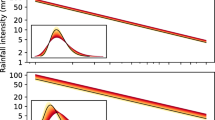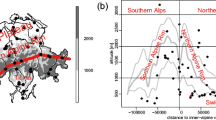Abstract
This paper presents applications of the peaks-over-threshold methodology for both the univariate and the recently introduced bivariate case, combined with a novel bootstrap approach. We compare the proposed bootstrap methods to the more traditional profile likelihood. We have investigated 63 years of the European Climate Assessment daily precipitation data for five Hungarian grid points, first separately for the summer and winter months, then aiming at the detection of possible changes by investigating 20 years moving windows. We show that significant changes can be observed both in the univariate and the bivariate cases, the most recent period being the most dangerous in several cases, as some return values have increased substantially. We illustrate these effects by bivariate coverage regions.








Similar content being viewed by others
Notes
The (old) parameter σ in terms of ξ and H −1(q): \(\sigma = \sigma (\xi ,H^{-1}(q)) =\frac {\xi H^{-1}(q)}{(1-q)^{-1}-1}.\)
This means in average \(\frac {n}{l}\) observations in a single year.
Special case of Theorem 2.6 in Coles (2001).
References
Balkema AA, De Haan L (1974) Residual life time at great age. Ann Probab:792–804
Bartholy J, Pongrácz R (2007) Regional analysis of extreme temperature and precipitation indices for the Carpathian Basin from 1946 to 2001. Glob Planet Chang 57:83–95
Bartholy J, Pongrácz R (2010) Analysis of precipitation conditions for the Carpathian Basin based on extreme indices in the 20th century and climate simulations for the 21st century. Phys Chem Earth 35:43–51
Bartholy J, Pongrácz R, Gelybó G (2007) Regional climate change expected in Hungary for 2071–2100. Appl Ecol Environ Res 5(1):1–17
Beguería S, Vicente-Serrano SM (2006) Mapping the hazard of extreme rainfall by peaks over threshold extreme value analysis and spatial regression techniques. J Appl Meteorol Climatol 45(1):108–124
Beran R (1988) Prepivoting test statistics: a bootstrap view of asymptotic refinements. J Am Stat Assoc 83 (403):687–697
Bhattacharya A, Bose A (2012) Resampling in time series models. arXiv:1201.1166
Bücher Axel, Dette Holger (2010) A note on bootstrap approximations for the empirical copula process. Statistics & Probability Letters 80(23):1925–1932
Chernick MR (2011) Bootstrap methods: a guide for practitioners and researchers, vol 619. Wiley-Interscience
Chou C, Chiang JCH, Lan C-W, Chung C-H, Liao Y-C , Lee C-J (2013) Increase in the range between wet and dry season precipitation. Nat Geosci 6(4):263–267
Coles S (2001) An introduction to statistical modeling of extreme values. Springer
Dan’azumi S, Shamsudin S, Aris A (2010) Modeling the distribution of rainfall intensity using hourly data. Am J Environ Sci 6(3):238
Davidson R, Flachaire E (2008) The wild bootstrap, tamed at last. J Econ 146(1):162–169
Davison AC, Hinkley DV (1997) Bootstrap methods and their application, vol 1. Cambridge University Press
Domonkos P (2003) Recent precipitation trends in Hungary in the context of larger scale climatic changes. Nat Hazards 29(2):255–271
Dunn PK (2004) Occurrence and quantity of precipitation can be modelled simultaneously. Int J Climatol 24(10):1231–1239
Feng X, He X, Hu J (2011) Wild bootstrap for quantile regression. Biometrika 98(4):995–999
Flachaire E (2005) Bootstrapping heteroskedastic regression models: wild bootstrap vs. pairs bootstrap. Comput Stat Data Anal 49(2):361–376
Haylock M, Hofstra N, Tank AMGK, Klok EJ, Jones PD, New M (2008) A European daily high-resolution gridded data set of surface temperature and precipitation for 1950–2006. J Geophys Res Atmos 113(D20):1984–2012
Hofstra N, Haylock M, New M, Jones PD (2009) Testing E-OBS European high-resolution gridded data set of daily precipitation and surface temperature. J Geophys Res Atmos 114(D21):1984–2012
Hundecha Y, Bárdossy A (2005) Trends in daily precipitation and temperature extremes across western Germany in the second half of the 20th century. Int J Climatol 25(9):1189–1202
Kyselỳ J (2008) A cautionary note on the use of nonparametric bootstrap for estimating uncertainties in extreme-value models. J Appl Meteorol Climatol 47(12):3236– 3251
Kyselỳ J, Gaál L, Picek J (2011) Comparison of regional and at-site approaches to modelling probabilities of heavy precipitation. Int J Climatol 31(10):1457–1472
Pickands J (1981) Multivariate extreme value distributions. In: Proceedings 43rd session international statistical institute, vol 2, pp 859–878
Pickands J III (1975) Statistical inference using extreme order statistics. Ann Stat:119–131
Rakonczai P (2012) mgpd: Functions for multivariate generalized Pareto distribution (MGPD of type II), http://CRAN.R-project.org/package=mgpd. R package version 1.99
Rakonczai P, Tajvidi N (2012) On prediction of bivariate extremes. Int J Intell Technol Appl Stat 3(2):115–139
Rakonczai P, Zempléni A (2012) Bivariate generalized Pareto distribution in practice: models and estimation. Environmetrics 23(3):219–227
Rana S, Midi H, Rahmatullah Imon AHM (2012) Robust wild bootstrap for stabilizing the variance of parameter estimates in heteroscedastic regression models in the presence of outliers. Math Probl Eng
Rootzén H, Tajvidi N (2006) Multivariate generalized Pareto distributions. Bernoulli 12(5):917–930
Tank AMGK, Können GP (2003) Trends in indices of daily temperature and precipitation extremes in Europe, 1946–99. J Clim 16:3665–3680
Uboldi F, Sulis AN, Lussana C, Cislaghi M, Russo M (2013) A spatial bootstrap technique for parameter estimation of rainfall annual maxima distribution. Hydrol Earth Syst Sci 10:11755–11794
Varga L, Zempléni A (2012) Weighted bootstrap in GARCH models. arXiv:1209.1302
Wang SX (2001) Maximum weighted likelihood estimation. PhD thesis, University of British Columbia
Acknowledgments
P. Rakonczai’s research was supported by an whitei OTKA mobility grant (OTKA registration number: MB08A 84576, PKR registration number: HUMAN-MB08-1-2011-0007). The work of L. Varga was supported by the European Union Social Fund (Grant Agreement No. TÁMOP 4.2.1/B-09/1/KMR-2010-0003).
Author information
Authors and Affiliations
Corresponding author
Rights and permissions
About this article
Cite this article
Varga, L., Rakonczai, P. & Zempléni, A. Applications of threshold models and the weighted bootstrap for Hungarian precipitation data. Theor Appl Climatol 124, 641–652 (2016). https://doi.org/10.1007/s00704-015-1438-6
Received:
Accepted:
Published:
Issue Date:
DOI: https://doi.org/10.1007/s00704-015-1438-6




